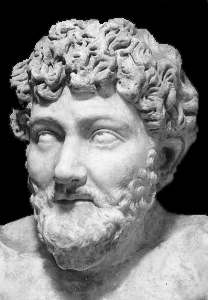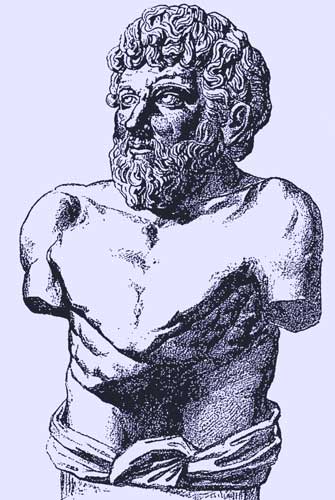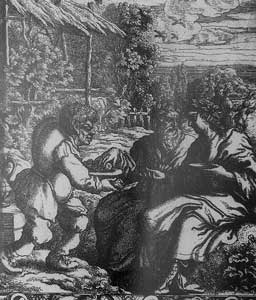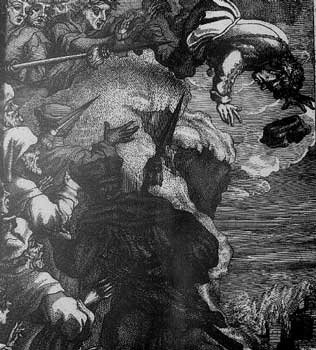.
Leader of the Chorus. By God, I never knew that before!
Pisthetaerus. That`s because you are ignorant and heedless and have never read your Aesop”
Aristophanes Birds
Aesop statue, Villa Albani, Rome
According to a story Aesop acquired his skill of writing Fables when he helped a priestess of the goddess Isis. Isis response was to help the slave Aesop. He was "kissed" by the Muses and from that moment he was able to write his famous stories.
Aesop, or Æsop (from the Greek Aisopos, Αἴσωπος, Αίσωπος ), famous for his Fables, is supposed to have lived from about 620 to 560 B.C. Aesop's Fables are still taught as moral lessons and used as subjects for various entertainments especially children's plays and cartoons.
The place of his birth is uncertain--Thrace, Phrygia, Aethiopia, Samos, Athens and Sardis all claiming the honour. Some scholars believe that he could have been African. His given name, Aesop, is the Ancient Greek word for "Ethiop," the archaic word for a dark-skinned person of African origin. This, if true, would make the picture at right highly incorrect. We possess little trustworthy information concerning his life, except that he was the slave of Iadmon of Samos and met with a violent death at the hands of the inhabitants of Delphi. A pestilence that ensued being attributed to this crime, the Delphians declared their willingness to make compensation, which, in default of a nearer connection, was claimed and received by Iadmon, the grandson of his old master. Herodotus, who is our authority for this (ii. 134), does not state the cause of his death; various reasons are assigned by later writers--his insulting sarcasms, the embezzlement of money entrusted to him by Croesus for distribution at Delphi, the theft of a silver cup.
Aesop must have received his freedom from Iadmon, or he could not have conducted the public defence of a certain Samian demagogue (Aristotle, Rhetoric, ii. 20). According to the story, he subsequently lived at the court of Croesus, where he met Solon, and dined in the company of the Seven Sages of Greece with Periander at Corinth. During the reign of Peisistratus he is said to have visited Athens, on which occasion he related the fable of The Frogs asking for a King, to dissuade the citizens from attempting to exchange Peisistratus for another ruler.
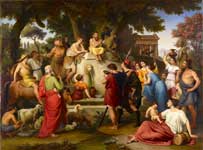
The popular stories current regarding him are derived from a life, or rather romance, prefixed to a book of fables, purporting to be his, collected by Maximus Planudes, a monk of the 14th century. In this he is described as a monster of ugliness and deformity, as he is also represented in a well-known marble figure in the Villa Albani at Rome. That this life, however, was in existence a century before Planudes, appears from a 13th-century manuscript of it found at Florence. In Plutarch's Symposium of the Seven Sages, at which Aesop is a guest, there are many jests on his original servile condition, but nothing derogatory is said about his personal appearance. We are further told that the Athenians erected in his honour a noble statue by the famous sculptor Lysippus, which furnishes a strong argument against the fiction of his deformity. Lastly, the obscurity in which the history of Aesop is involved has induced some scholars to deny his existence altogether.
It is probable that Aesop did not commit his fables to writing; Aristophanes (The Wasps, 1259) represents Philocleon as having learnt the "absurdities" of Aesop from conversation at banquets) and Socrates whiles away his time in prison by turning some of Aesop's fables "which he knew" into verse (Plato, Phaedo, 61 b). Demetrius of Phalerum (345-283 B.C.) made a collection in ten books, probably in prose (Lopson Aisopeion sunagogai) for the use of orators, which has been lost. Next appeared an edition in elegiac verse, often cited by Suidas, but the author's name is unknown. Babrius, according to Crusius, a Roman and tutor to the son of Alexander Severus, turned the fables into choliambics in the earlier part of the 3rd century A.D. The most celebrated of the Latin adapters is Phaedrus, a freedman of Augustus. Avianus (of uncertain date, perhaps the 4th century) translated 42 of the fables into Latin elegiacs.
The collections which we possess under the name of Aesop's Fables are late renderings of Babrius's Version or Progumnasmata, rhetorical exercises of varying age and merit. Syntipas translated Babrius into Syriac, and Andreopulos put the Syriac back again into Greek. Ignatius Diaconus, in the 9th century, made a version of 55 fables in choliambic tetrameters. Stories from Oriental sources were added, and from these collections Maximus Planudes made and edited the collection which has come down to us under the name of Aesop, and from which the popular fables of modern Europe have been derived.
In the early 1200s some of Aesop's tales were adapted for use in the European Jewish community by Berechiah ha-Nakdan, a Jewish exegete, ethical writer, grammarian, and translator; his name means "Berechiah the Puntuator (or grammarian)", indicating his possible profession. Today he is best known for his Hebrew work, Mishlei Shualim, which appears to be derived from a collection of Aesop's fables, from the French writer Ysopet of Marie de France (c.1170). Berechiah's work adds a layer of Biblical quotations and allusions in the tales, adapting them as a way to teach Jewish ethics.
Before any Greek text appeared, a Latin translation of 100 Fabulae Aesopicae by an Italian scholar named Ranuzio (Renutius) was published at Rome, 1476. About 1480 the collection of Planudes was brought out at Milan by Buono Accorso (Accursius), together with Ranuzio's translation. This edition, which contained 144 fables, was frequently reprinted and additions made from time to time from various manuscripts --the Heidelberg (Palatine), Florentine, Vatican and Augsburg-- by Stephanus (1547), Nevelet (1610), Hudson (1718), Hauptmann (1741), Furia (1810), Coray (1810), Schneider (1812) and others. A critical edition of all the previously known fables, prepared by Carl von Halm from the collections of Furia, Coray and Schneider, was published in the Teubner series of Greek and Latin texts. A Fabularum Aesopicarum sylloge (233 in number) from a Paris manuscript, with critical notes by Sternbach, appeared in a Cracow University publication, Rozprawy akademii umiejetinosci (1894).
Jean de la Fontaine, the French poet, took his inspiration into the Aesop's fables to write his Fables Choisies (1668).
Brazilian dramatist Guilherme Figueiredo wrote a play The Fox and the Grapes (A raposa e as uvas) (1953) about Aesop's life. It was staged many times in the world's best theaters.

Aesop, Diego Velasquez
List of some fables by Aesop
The "Wolf in Sheep's Clothing" fable is used in this World War II Soviet propaganda poster to allude to German treachery in Operation Barbarossa
See all of Aesop's fables (translated) on wikisource:Aesop's Fables.
His most famous ones include:
The Ant and the Grasshopper
The Boy Who Cried Wolf
The Dog and the Bone
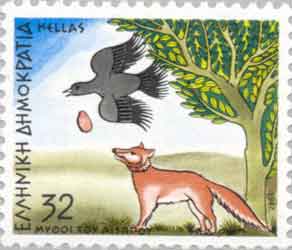
The Fox and the Crow
The Fox and the Grapes
The Goose that Laid the Golden Eggs
The Lion and the Mouse
The North Wind and the Sun

The Hare and the Tortoise ,
The Town Mouse and the Country Mouse
The Wolf in Sheep's Clothing
The Frogs Pick a King (aka King Log and King Stork)
Sources
Caxton, John, 1484. The history and fables of Aesop, Westminster. Modern reprint edited by Robert T. Lenaghan (Harvard University Press: Cambridge, 1967).
Caxton's famous Epilogue (http://www.bartleby.com/39/7.html)
Bentley, Richard, 1697. Dissertation upon the Epistles of Phalaris... and the Fables of Æsop. London.
Jacobs, Joseph, 1889. The Fables of Aesop: Selected, Told Anew, and Their History Traced: i. a short history of the Aesopic fable (http://etext.library.adelaide.edu.au/a/aesop/a3j/a3j_hist.html); ii. The Fables of Aesop, as first printed by William Caxton, 1484, from his French translation
Handford, S. A., 1954. Fables of Aesop. New York: Penguin.
Perry, Ben E. (editor), 1965. Babrius and Phaedrus, (Loeb Classical Library) Cambridge: Harvard University Press, 1965. English translations of 143 Greek verse fables by Babrius, 126 Latin verse fables by Phaedrus, 328 Greek fables not extant in Babrius, and 128 Latin fables not extant in Phaedrus (including some medieval materials) for a total of 725 fables.
Temple, Olivia and Robert (translators), 1998. Aesop, The Complete Fables, New York: Penguin Classics. Greek prose fables. ISBN 0-14-044649-4 Bryn Mawr Classical Review, with Aesop bibliography (http://ccat.sas.upenn.edu/bmcr/1998/98.5.16.html)
German
Hans Joachim Schädlich: Gib ihm Sprache. Leben und Tod des Dichters Äsop. Rowohlt-Verlag, Reinbek 1999.
Links
AesopWorks by Aesop (http://www.gutenberg.org/author/Aesop) at Project Gutenberg
Aesop's fables recounted by Edwin Hayward the bear (http://www.edwinhayward.co.uk)
AesopFables.com - Large collection of fables alongwith drawings, readings, and history (http://www.aesopfables.com)
Aesop's Fables - Collection of over 500 fables (http://www.elook.org/literature/aesop/fables/)
http://www.literature.org/authors/aesop/fables/biography.htm
| Ancient Greece
Science, Technology , Medicine , Warfare, , Biographies , Life , Cities/Places/Maps , Arts , Literature , Philosophy ,Olympics, Mythology , History , Images Medieval Greece / Byzantine Empire Science, Technology, Arts, , Warfare , Literature, Biographies, Icons, History Modern Greece Cities, Islands, Regions, Fauna/Flora ,Biographies , History , Warfare, Science/Technology, Literature, Music , Arts , Film/Actors , Sport , Fashion --- |
Retrieved from "http://en.wikipedia.org"
All text is available under the terms of the GNU Free Documentation License

